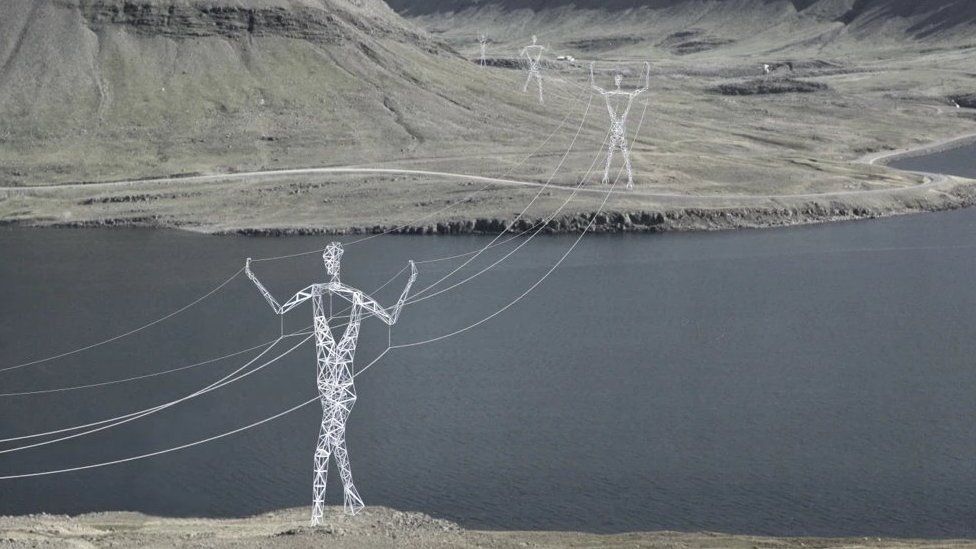ARTICLE AD BOX
 Image source, Choi+Shine Architects
Image source, Choi+Shine Architects
The Land of Giants - pylons designed by Choi+Shine Architects
Most people seem to view electricity pylons as a blight - ugly landmarks towering over the landscape.
There are online communities who view them as beautiful, but there's concern local resistance could hamper the government's plans to build a huge number of new power lines as the country moves towards greater use of renewable power.
In a bid to counter opposition, Chancellor Jeremy Hunt is expected to announce that households living close to new pylons and electricity substations could get up to £1,000 a year off their energy bills.
But could communities feel more favourable to pylons if they had a different look?
Some design companies have had a go at providing alternatives.
Back in 2008, US-based architects Choi + Shine came up with the idea of making pylons that look like huge human sculptures - a project entitled Land of Giants.
Jin Choi explains she had the idea when she and Thomas Shine were driving to Montreal.
"There were miles of pylons running next to the road - I though they were like a hybrid between real giants and insects.
"It feels as though it is not you who are moving - they are the ones that are moving, like they are approaching you."
After seeing her sketches, Thomas was instantly captivated by the idea: "Once someone shows it to you, you can't unsee it."
Image source, Choi + Shine Architects
Image caption,Designs from the Land of Giant project show human-style figures
Image source, Choi + Shine architects
Image caption,Choi + Shine architects have also applied their designs to wind turbines
The pair argue there is no reason why infrastructure shouldn't be attractive.
"When someone designs a bridge it is accepted it should be beautiful, when someone builds a power station no-one thinks it should be beautiful," says Thomas.
Despite winning a competition run by an Icelandic power company, their pylon giants have yet to be built anywhere in the world.
The designers say the issue isn't necessarily one of cost, pointing out that their pylons are made out of the same material as a regular pylon, simply put together in a different way.
They add that there can be political wrangling over who gets to have one of the pylons in their area.
A proposal in Norway faltered after a local mayor - spotting the visitor attraction potential of the structures - agreed they could be built in his town, as long as they weren't built anywhere else in the country.
The designs have also been considered in New Mexico, Georgia and Chile.
Jin acknowledges she has some frustration that, despite plenty of attention, the designs have not so far been constructed. "Of course it is difficult, I wouldn't pretend it isn't, but it is better than no interest.
"I've started calling it the burden of dreams - the price to pay to have this privilege to keep dreaming."
Others have also tried to improve the look of pylons. In 2010 artists transformed a pylon in Essen, Germany:
Image source, Frank Peterschroeder
Image caption,A pylon designed by artists Ail Hwang, Chung-Ki Park, Hae-Ryun Jeong
Image source, Frank Peterschroeder
Image caption,The colourful design was used in Essen, Germany
Image source, Getty Images
Image caption,In Hungary, a pylon was built to resemble a clown
Image source, Getty Images
Image caption,In Florida, home of Disney World, a pylon is shaped in the silhouette of a familiar cartoon mouse
Maybe if you can't "beautify" infrastructure, the answer lies in trying to camouflage it.
Last year, telecoms company Three built a phone mast in South Queensferry, Scotland which was designed to look like a tree. A spokesperson for Three said that, having consulted with the local community, they decided a mast in the style of a tree would "coordinate with the broader surroundings".
The planning application attracted some complaints, with one local arguing the structure looked "utterly ridiculous" and another saying it would be "inconceivable that this will blend in".
Image source, Headland consultancy
Image caption,Three's tree phone mast in South Queensferry
Disguising every pylon in the country would likely be expensive and impractical; however the National Grid has made efforts to change the traditional design of a pylon into something less obtrusive.
In 2011, along with the Royal Institute of British Architects, it launched a competition to find a new model of pylon - the first major redesign since 1927.
The eventual winner was Danish architect Bystrup, with a giant T design with two diamonds hanging off either end.
The structure means the height of the pylon is reduced by a third, compared to traditional models, as well as being quicker to put up.
The first of these models were built and energised earlier this year between Bridgwater and Loxton in Somerset.
Local residents have compared the new structures to, among other things, Pat Butcher from EastEnders' earrings, MC Hammer and a contraceptive coil.
The National Grid says it received more than 11,000 pieces of feedback about the pylons and most people expressed a preference for T-pylons over the lattice versions.
Image source, National Grid
Image caption,Somerset has become home to the first of a new generation of pylons
Another alternative to making pylons more amenable to the local population is to incentivise people.
It has already been tried in Ireland where people living within 200m of a new overhead line or transmission station can get €2,000-30,000, depending on how close they are, and the capacity of the line.
And earlier this year, energy expert Nick Winser in his report for the UK government recommended this approach.
He argued that the cost of compensation would be lower than building cables underground which costs between five and 10 times more than overhead lines.
The government appears to have accepted this recommendation, with the chancellor expected to set out details on Wednesday in his Autumn Statement.
But, maybe instead of making pylons prettier and smaller, disguising them as trees, or paying people to put up with them, it would be cheaper and easier to simply learn to love the pylon for what it is.
Kevin Mosedale - founder of the slightly tongue-in-cheek Pylon of the Month blog - says he can understand why people might not want to live near the structures.
However, he argues they can be beautiful "in their own way" and uses his blog to celebrated them.
They have, he says quoting architectural writer Jonathan Glancey, a "gaunt skeletal beauty".

 1 year ago
25
1 year ago
25








 English (US) ·
English (US) ·